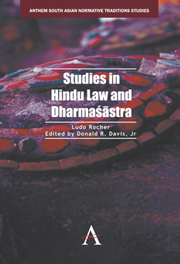Book contents
- Frontmatter
- Contents
- Foreword by Richard W. Lariviere
- Preface
- Abbreviations
- Note on the Edition
- Introduction
- PART ONE THE NATURE OF HINDU LAW
- Hindu Conceptions of Law
- The Historical Foundations of Ancient Indian Law
- Hindu Law and Religion: Where to Draw the Line
- Law Books in an Oral Culture: The Indian Dharmaśūstras
- Schools of Hindu Law
- Changing Patterns of Diversification in Hindu Law
- PART TWO GENERAL TOPICS OF HINDU LAW
- PART THREE HINDU LEGAL PROCEDURE
- PART FOUR TECHNICAL STUDIES OF HINDU LAW
- PART FIVE ANGLO-HINDU AND CUSTOMARY LAW
- Bibliography
- Index
Hindu Law and Religion: Where to Draw the Line
from PART ONE - THE NATURE OF HINDU LAW
Published online by Cambridge University Press: 05 February 2013
- Frontmatter
- Contents
- Foreword by Richard W. Lariviere
- Preface
- Abbreviations
- Note on the Edition
- Introduction
- PART ONE THE NATURE OF HINDU LAW
- Hindu Conceptions of Law
- The Historical Foundations of Ancient Indian Law
- Hindu Law and Religion: Where to Draw the Line
- Law Books in an Oral Culture: The Indian Dharmaśūstras
- Schools of Hindu Law
- Changing Patterns of Diversification in Hindu Law
- PART TWO GENERAL TOPICS OF HINDU LAW
- PART THREE HINDU LEGAL PROCEDURE
- PART FOUR TECHNICAL STUDIES OF HINDU LAW
- PART FIVE ANGLO-HINDU AND CUSTOMARY LAW
- Bibliography
- Index
Summary
S.V. Gupte's Hindu Law in British India enunciates the following general principle:
The Courts are to enforce only rules of positive law and not religious or moral precepts. It will be recalled that the Smritis and the Commentaries and Digests contain a considerable admixture of law and religion. Therefore, in applying the rules contained in the Smritis and the Commentaries and Digests, the principal question is whether a particular rule is a rule of positive law or a religious or a moral precept, for the Courts are concerned with rules of positive law only. (1947: 49)
This statement implies two important points: British Indian law was aware of the existence, within Hindu law, of “a considerable admixture of law and religion,” and those who were called upon to apply it thought that they could and should separate the “rules of positive law” from the “religious or moral precepts.” What is more, they decided that only the “rules of positive law” had to be taken into account in the Courts, whereas the so-called “religious or moral percepts” need not.
As usual, a rule such as the one mentioned above: “The Courts are to enforce only rules of positive law and not religious or moral precepts,” had found its way into textbooks on Hindu law only after having been formulated by some of the more prominent judges or by a bench —often the Privy Council— in a number of specific cases. I shall briefly discuss at least one of these cases, because it will bring us a step closer to the thesis which I propose to defend in this paper.
- Type
- Chapter
- Information
- Studies in Hindu Law and Dharmasastra , pp. 83 - 102Publisher: Anthem PressPrint publication year: 2012
- 1
- Cited by



